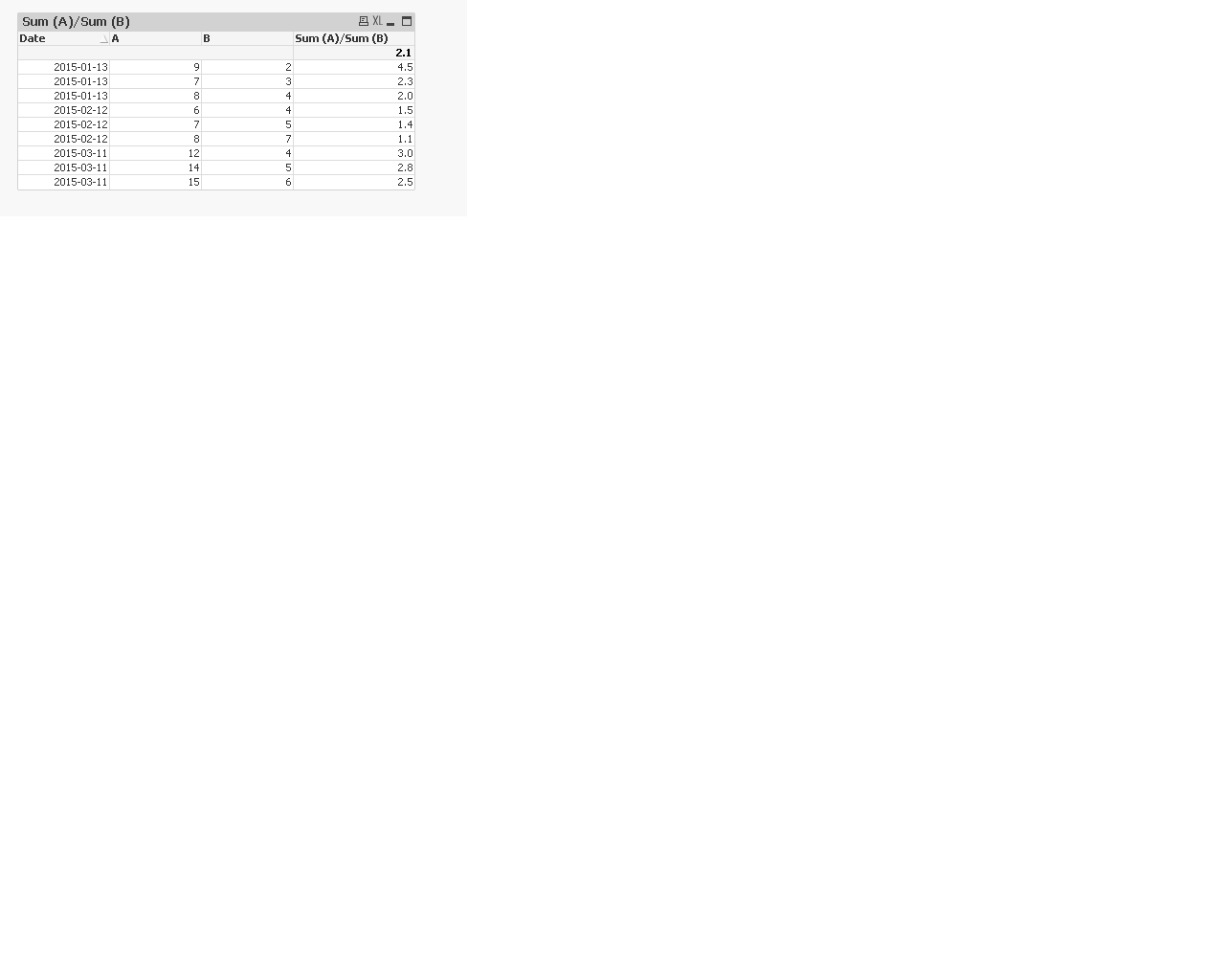Unlock a world of possibilities! Login now and discover the exclusive benefits awaiting you.
- Qlik Community
- :
- All Forums
- :
- QlikView App Dev
- :
- Re: Fixed Column Analysis
- Subscribe to RSS Feed
- Mark Topic as New
- Mark Topic as Read
- Float this Topic for Current User
- Bookmark
- Subscribe
- Mute
- Printer Friendly Page
- Mark as New
- Bookmark
- Subscribe
- Mute
- Subscribe to RSS Feed
- Permalink
- Report Inappropriate Content
Fixed Column Analysis
Hi,
I've got a problem which is easy to solve in Excel but is proving intractable in QlikView. I have a chart as such:
2015-01-13 2015-02-12 2015-03-11
A B C A B C A B C
9 2 2.25 8 7 2 12 4 3
7 3 1.16 6 4 1 15 6 2.5
8 4 1.6 7 5 1.4 14 5 2.8
Now, consider the following:
- Column C (Green) is a calculated column. C = A/B
- Also notice that Column C is calculated using Column A (Blue) in each set but only Column B (Red) from the last set
(2015-03-11). This is why the Column Bs in the first two sets (2015-01-13 & 2015-02-12) are left gray.
How can I do this in QlikView? In Excel it's a simple task of "locking" one column and dynamically calculating from the others. In QlikView this does not seem possible.
Any help is much appreciated.
-Abhijeet.
Accepted Solutions
- Mark as New
- Bookmark
- Subscribe
- Mute
- Subscribe to RSS Feed
- Permalink
- Report Inappropriate Content
I prefer to create a variable for whatever date you need and then add that into the set analysis
SUM(A)/Sum(TOTAL <Customer> {<Date = {'$(=vMaxDate)'}>}B) !
- Mark as New
- Bookmark
- Subscribe
- Mute
- Subscribe to RSS Feed
- Permalink
- Report Inappropriate Content
Probably something like this:
Sum(A)/Sum({<Date = {'$(=Min(Date))'}>}B)
Best,
S
- Mark as New
- Bookmark
- Subscribe
- Mute
- Subscribe to RSS Feed
- Permalink
- Report Inappropriate Content
Thanks but I've already tried that with no luck. This approach only gives me a value for Column C in the set with the Min(Date), and Column C in the other sets (other dates) show up blank.
The Set analysis here seems to interpret that it should take A and divide by B, but only if the Date above B is min(Date) (or max as the case may be in this example).
Set analysis doesn't seem to work here. Neither do alternate states.
Ab
- Mark as New
- Bookmark
- Subscribe
- Mute
- Subscribe to RSS Feed
- Permalink
- Report Inappropriate Content
What if we add a 1 to the equation here. Can you try this?
Sum(A)/Sum({1<Date = {'$(=Min(Date))'}>}B)
Best,
S
- Mark as New
- Bookmark
- Subscribe
- Mute
- Subscribe to RSS Feed
- Permalink
- Report Inappropriate Content
Would you be able to share a sample file where I can play around with a little.
Best,
S
- Mark as New
- Bookmark
- Subscribe
- Mute
- Subscribe to RSS Feed
- Permalink
- Report Inappropriate Content
Attached to original post. Thanks again for your help!
Ab.
- Mark as New
- Bookmark
- Subscribe
- Mute
- Subscribe to RSS Feed
- Permalink
- Report Inappropriate Content
I prefer to create a variable for whatever date you need and then add that into the set analysis
SUM(A)/Sum(TOTAL <Customer> {<Date = {'$(=vMaxDate)'}>}B) !
- Mark as New
- Bookmark
- Subscribe
- Mute
- Subscribe to RSS Feed
- Permalink
- Report Inappropriate Content
This appears to work. Thank you!
Ab.
- Mark as New
- Bookmark
- Subscribe
- Mute
- Subscribe to RSS Feed
- Permalink
- Report Inappropriate Content
Hi,
Try like this in Straight table.
